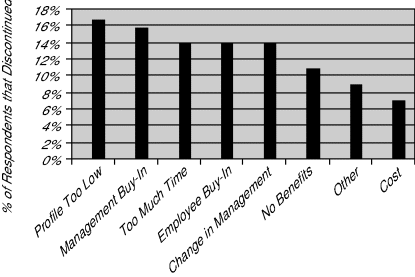Background
From the SHAPs (i.e., SUNY, Hyperion, and Pepperdine scorecard) study, about 8 percent of the respondents indicated they had implemented a scorecard system but had not realized significant benefits. Another 10 percent of respondents discontinued use of their implemented scorecard system. Examining each of these sets of organizations yielded very similar reasons for these results. Many were related to not having a supportive organizational environment. Exhibit 4.1 shows the reasons given by organizations for discontinuing use of their scorecard system. The top four reasons are:
The system did not have a high enough profile.
There was no buy‐in from management.
The system was too time consuming.
There was no buy‐in from employees.
Exhibit 4.1: Reasons for Discontinuing

At least three of the top four reasons point to a nonsupportive organizational environment, further emphasizing the importance of having a culture of strategic awareness and strategic transparency.
By itself, the introduction of any new system is unlikely to drive change throughout the organization. Imagine the introduction of a system that provides up‐to‐date information on performance measure results for which you believe that you have no responsibility and is not useful for your job function. It is hard to think that you would have more than a passing interest in these results—and your daily routine and goals ...
Get Scorecard Best Practices now with the O’Reilly learning platform.
O’Reilly members experience books, live events, courses curated by job role, and more from O’Reilly and nearly 200 top publishers.

